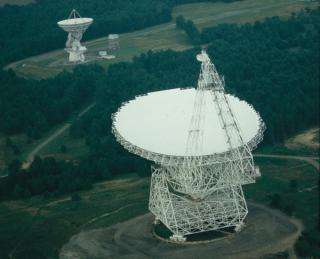Negative Vibes From Space

Astronomers have discovered the first negatively charged molecule in space, identifying it from radio signals that were a mystery until now. While about 130 neutral and 14 positively charged molecules are known to exist in interstellar space, this is the first negative molecule, or anion, to be found.
"We've spotted a rare and exotic species, like the white tiger of space," said astronomer Michael McCarthy of the Harvard-Smithsonian Center for Astrophysics (CfA).
By learning more about the rich broth of chemicals found in interstellar space, astronomers hope to explain how the young Earth converted these basic ingredients into the essential chemicals for life. This new finding helps to advance scientists' understanding of the chemistry of the interstellar medium, and hence the birthplaces of planets.
McCarthy worked with CfA colleagues Carl Gottlieb, Harshal Gupta (also from the Univ. of Texas), and Patrick Thaddeus to identify the molecular anion known as C6H-: a linear chain of six carbon atoms with one hydrogen atom at the end and an "extra" electron. Such molecules were thought to be extremely rare because ultraviolet light that suffuses space easily knocks electrons off molecules. The large size of C6H-, larger than most neutral and all positive molecules known in space, may increase its stability in the harsh cosmic environment.
"The discovery of C6H- resolves a long-standing enigma in astrochemistry: the apparent lack of negatively charged molecules in space," stated Thaddeus.
The team first conducted laboratory experiments to determine exactly what radio frequencies to use in their search. Then, they used the National Science Foundation's Robert C. Byrd Green Bank Telescope to hunt for C6H- in celestial objects. In particular, they targeted locations in which previous searches had spotted unidentified radio signals at the appropriate frequencies.
They found C6H- in two very different locations-a shell of gas surrounding the evolved red giant star IRC +10216 in the constellation Leo, and the cold molecular cloud TMC-1 in Taurus. The presence of the anion in both regions shows that the chemical processes that form C6H- are ubiquitous. It also suggests that other molecular anions are present and will be found in the near future.
"This finding is dramatic evidence that our understanding of interstellar chemistry is still quite rudimentary. It also implies that more molecular anions, perhaps many, may now be found in the laboratory and in space," said McCarthy.
This research will appear in the December 1 issue of The Astrophysical Journal Letters.
Source: Harvard-Smithsonian Center for Astrophysics



















